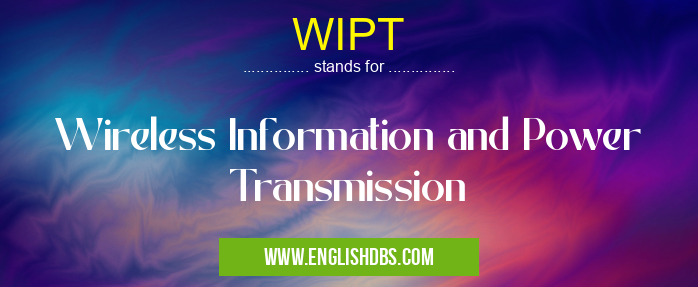What does WIPT mean in UNCLASSIFIED
WIPT stands for Wireless Information and Power Transmission. It is a technology that combines wireless power transmission with wireless information transmission. This technology allows for simultaneous transfer of electrical power and data over the air, without the need for physical connections.

WIPT meaning in Unclassified in Miscellaneous
WIPT mostly used in an acronym Unclassified in Category Miscellaneous that means Wireless Information and Power Transmission
Shorthand: WIPT,
Full Form: Wireless Information and Power Transmission
For more information of "Wireless Information and Power Transmission", see the section below.
Functionality
WIPT systems typically consist of a transmitter and a receiver. The transmitter generates an electromagnetic field that carries both power and information. The receiver converts the electromagnetic field into usable electrical power and extracts the information signal.
Applications
WIPT has numerous potential applications, including:
- Wireless charging: Charging devices such as smartphones, laptops, and electric vehicles without the need for cables.
- Wireless IoT sensors: Powering and communicating with wireless sensors in remote or inaccessible locations.
- Medical implants: Wireless powering and communication with medical implants, such as pacemakers and insulin pumps.
- Industrial automation: Powering and controlling robots and other industrial equipment wirelessly.
- Telecommunication: Providing power and communication for base stations and other telecommunication infrastructure.
Benefits
WIPT offers several advantages over traditional wired or inductive power transmission methods:
- Convenience: Eliminates the hassle and limitations of cables and connectors.
- Accessibility: Allows for power and communication in areas where wires are impractical or impossible to install.
- Safety: Reduces the risk of electrical accidents associated with exposed wires.
- Versatility: Supports a wide range of applications and devices.
Challenges
However, WIPT also faces some challenges:
- Power efficiency: Ensuring efficient power transfer over the air.
- Interference: Mitigating interference from other wireless signals and devices.
- Safety regulations: Establishing appropriate safety standards for wireless power transmission.
Essential Questions and Answers on Wireless Information and Power Transmission in "MISCELLANEOUS»UNFILED"
What is Wireless Information and Power Transmission (WIPT)?
WIPT is a technology that enables the simultaneous transmission of both information and electrical power through the air, without the need for physical wires or cables.
How does WIPT work?
WIPT uses electromagnetic waves to transmit both information and power. The information is modulated onto a carrier wave, which is then transmitted through a transmitting antenna. The power is transmitted through a separate power transmission antenna. At the receiving end, a receiving antenna receives the information and power, which are then demodulated and used to power devices.
What are the advantages of WIPT?
WIPT offers several advantages over traditional wired power transmission methods. Some of the key advantages include:
- Elimination of wires: WIPT eliminates the need for physical wires or cables, which can be unsightly and inconvenient.
- Flexibility and mobility: WIPT enables devices to be powered wirelessly, providing greater flexibility and mobility.
- Reduced installation costs: WIPT can reduce installation costs by eliminating the need for trenching and cabling.
- Increased safety: WIPT can improve safety by eliminating the risk of electrical shocks or fires caused by damaged wires.
What are the applications of WIPT?
WIPT has a wide range of potential applications, including:
- Wireless charging: WIPT can be used to wirelessly charge mobile phones, laptops, and other devices.
- Powering IoT devices: WIPT can power IoT devices such as sensors, actuators, and wearable devices.
- Industrial automation: WIPT can be used to power industrial robots, sensors, and other equipment in factories and warehouses.
- Medical devices: WIPT can be used to power implantable medical devices such as pacemakers and cochlear implants.
- Transportation: WIPT can be used to power electric vehicles, drones, and other transportation systems.
What are the challenges of WIPT?
WIPT faces several challenges, including:
- Power efficiency: The power efficiency of WIPT systems is still relatively low, which limits the range and power levels that can be transmitted.
- Interference: WIPT systems can be susceptible to interference from other wireless devices and environmental factors.
- Cost: WIPT systems can be expensive to implement, especially for large-scale applications.
What is the future of WIPT?
WIPT is a promising technology with the potential to revolutionize the way we power devices. As research and development continue, the power efficiency, range, and cost of WIPT systems are expected to improve, making WIPT a more viable option for a wide range of applications.
Final Words: WIPT is a promising technology that has the potential to revolutionize various industries and applications. By enabling wireless power and information transfer, WIPT offers convenience, accessibility, safety, and versatility. Ongoing research and development aim to address challenges and further improve the efficiency and reliability of WIPT systems.
